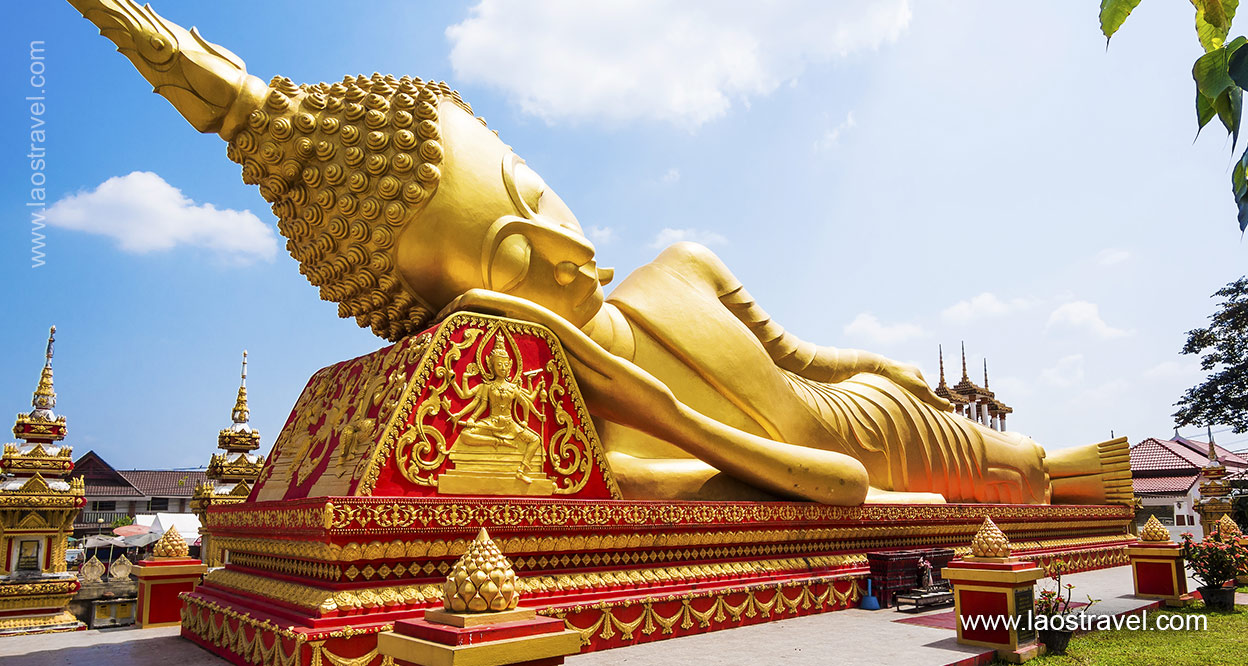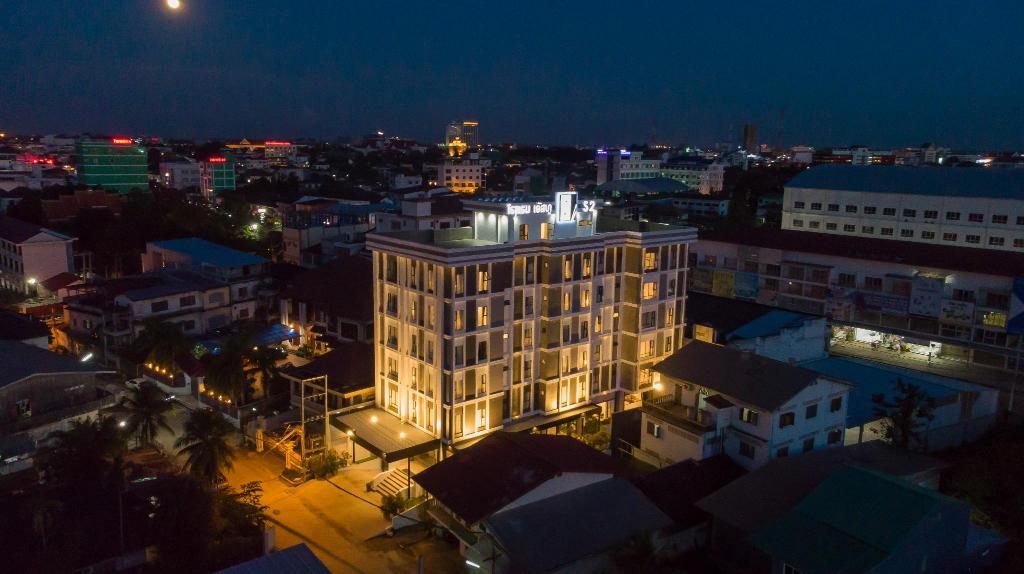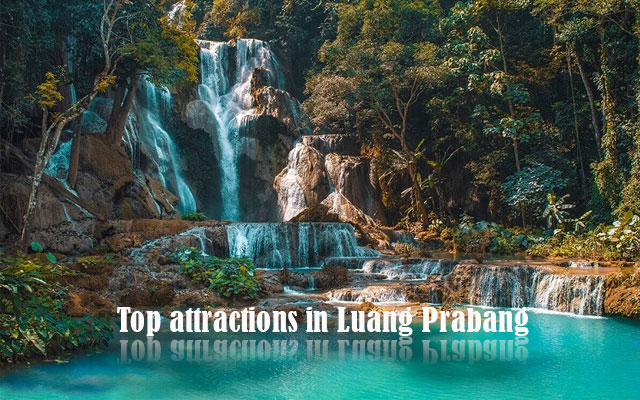Vientiane Travel Guide

Vientiane Travel Guide
Vientiane is the largest city of Laos, a landlocked country of South East Asia. Just like its entire country, this capital is at a pretty quiet and slow pace when compared to another bustling metropolis in the region. Lying on the mighty Mekong River, and was once a French trading post, Vientiane still keeps its colorful original colonial architecture intact. Nowadays, Laos has slowly opened up to the world with more foreign investment and tourism. As a result, Vientiane is stepped by step, undergoing its changes, and continues to expand with more things to discover.
It will be good things to know when to go, how to get there, where to stay, what to do, where to eat, and more before traveling to Vientiane. Here is our ultimate Vientiane travel guide to help you plan your perfect Laos experience!
Contents
Overview
History.
According to the great Laotian epic, it was believed that Prince Thattaradtha was the one who founded the city. At first, the city was called Maha Thani Si Phan Phao on the western banks of the Mekong River which was today’s Udon Thani, Thailand. Then, following snake God Naga told, Prince Thattaradtha started a new city on the east bank of the river called Chanthabuly Si Sattanakhanahud which was considered as the predecessor of modern Vientiane.
In 1354, Vientiane became an important administrative city when Fa Ngum founded the kingdom of Lan Xang.
In the mid-16th century, King Setthathirath officially established Vientiane as the capital of Lan Xang from its previous traditional location at Luang Prabang to avoid Burmese invasion, and built Wat Ho Phra Kaew to house the sacred Emerald Buddha as well as the impressive That Luang stupa on the site of an ancient Khmer temple east of the city which remains a major symbol of Laos and an important center for major Buddhist festivals.
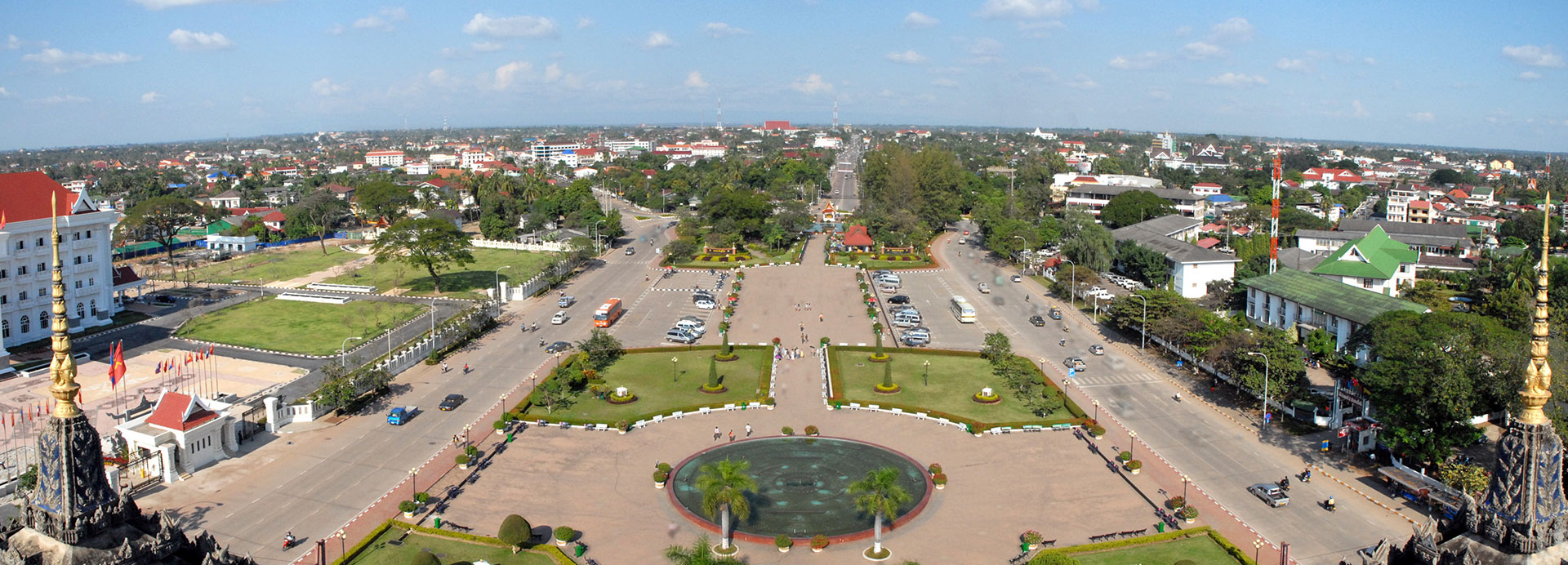
Vientiane view from Patuxai (source: Wikipedia)
Vientiane became the independent Kingdom of Vientiane after Lan Xang fell apart in 1707 until it was conquered again by the Siamese in 1778 to become a vassal of Siam and the Emerald Buddha was taken to Siam and remains in the Grand Palace of Bangkok now. By that time, Wat Sisaket was the only temple to survive the attack.
In 1828, Vientiane was sacked and destroyed when King Anouvong raised an unsuccessful rebellion against Siamese hegemony. Except for the occupation of the Japanese in 1945, Vientiane was under French rule from 1899 to 1953. During this time, many temples were rebuilt. After the withdrawal of the French, a lot of buildings were left behind which are now integral of daily life in the Laos capital.
From 1959, Vientiane became unstable during the Laotian Civil War between the Royal Lao Government and the Pathet Lao. In 1975, the communist party of the Pathet Lao took over Vientiane, then defeated the Kingdom of Laos and renamed the country the Lao People’s Democratic Republic.
In 2010, Vientiane celebrated its 450th birthday. Today’s Vientiane is a mixture of old and new as the city undergoes development into a modern city.
Other facts.
Geographical location: on a bend of the Mekong River, at which point it forms the border with Thailand.
Total Area: 130 km2 (50 sq mi)
Population of the city: 948,477 people (by 2020)
Elevation: 174 m (570 ft)
Post Code: 0100
Telephone Code: 21
Time Zone: UTC+7 (ICT)
Ethnic groups: the lowland Lao Loum and Lao Sung in the mountains, consisting of smaller ethnicities in Vientiane including the Hmong, Yao, Khmu, and Lao Theung.
Official Currency: Lao Kip (LAK). The denominations of notes: 500, 1,000, 2,000, 5,000, 10,000, 20,000, and 50,000. Besides, US dollar (USD) and Thai baht (THB) are also widely accepted.
Laos Languages: The national language is Lao. Besides, a small population can speak English, French. Other languages are also spoken in Vientiane such as Thai and ethnic minorities.
When to Visit Vientiane?
Vientiane features a tropical savanna climate (Köppen Aw) with 2 distinct seasons: wet season from April to October and dry season from November through March. Although the capital tends to be hot and humid throughout the year, temperatures in the city are somewhat cooler during the dry season than in the wet season.
The annual precipitation in Vientiane at approximately 1,660.5mm (65.37in) with average rainy days of 118, average humidity at 75%, monthly sunshine hours of 2,434.7, and average annual high-low temperature at 31.1oC (88oF) – 21.8oC (71.2oF).
August is the wettest month of the year with an average rainfall of 334.6mm (13.17 in) while the hottest month comes to April at 34.3oC (93.7oF) on average high. The coolest month will be January at the average low of 16.4oC (61.5oF).
The dry season is the best time to visit Vientiane when the weather of the area is consistently warm and dry. However, this period is also the busiest time of year as covering peak season (December, January) when the service prices become higher.
If you plan the travel in the wet season, the benefits that you can get, are fewer crowds and cheaper rates. Whatever season you choose to fit your schedule, Vientiane is still worth visiting with its own advantages.
How to Get to Vientiane?
Air (Airport code: VTE)
Located about 3km from the center of Vientiane, Wattay International Airport is currently the main and largest airport in Laos. Together with Luang Prabang International Airport, they are the two busiest airports of the country, serving both international and domestic flights.
There are intercontinental flights between Vientiane and some provinces of China, Eastern Asia, and South-Eastern Asia on Lao Airlines, AirAsia, China Eastern Airlines, China Southern Airlines, Air Busan, Jeju Air, Thai Airways, and Vietnam Airlines.
Domestic flights are operated on Lao Airlines – national brand and Laos Skyway which are two main carriers to Luang Prabang, Luang Namtha, Muang Xay, Pakse, Phonsavan, and Savannakhet.
At Wattay, travelers can find various services such as restaurants, currency exchange, shopping, tourist information, ATMs, and options for public transportation.
Road
As near the border with Thailand, visitors can enter Laos via Lao-Thai Friendship Bridge I (Nong Khai to Vientiane) where both visas on arrival and Laos E-Visa are accepted.
There are daily bus services operated between Vientiane and some provinces of Thailand such as Nong Khai, Udon Thani, and Khon Kaen.
Another regular bus service connecting Vientiane with the rest of the country is also provided. Vientiane’s public bus system is available but mostly from the outer suburbs than the city center.
Within the city, several options of vehicles that you can choose such as bicycles, motorbikes, tuk-tuk/jumbo, or taxis. Bicycle rental is a good way to get around Vientiane from 10,000-30,000 LAK (US $1.15-3.45) per day and can be made from your accommodation or shops around town (suggested Mixay Bike, Lao Bike). Tuk Tuk is also affordable at about 30,000LAK (US$ 3.45) for a 3-km ride. Jumbo is cheaper in larger group share, and usually costs no more than 10,000LAK (US$ 1.15) per trip. For taxis, try to negotiate before getting in if it is an unmetered taxi. You can hire a private taxi for a full day within the town at around 500,000LAK (US$ 55).
Railway
So far, Thanaleng Station is the only station on the Lao side for Bangkok–Thanaleng rail route. There are 4 direct trains from Hualamphong Station of Bangkok to Nong Khai or vice versa with estimated travel time is 9 hours 25 minutes by the fastest trains. Then, you take another train from Nong Khai to Thanaleng where you continue with bus/minivan to Vientiane (1-2 hours depending on vehicle type).
By the end of 2021, the Boten – Vientiane railway (also known as the China-Laos railway) will be expected to compete and become a new railway that connects Kunming in China to Vientiane in Laos in 414km.
What and Where to Eat in Vientiane?
When traveling to Vientiane, you will wonder what to eat and where to eat in this Laos capital.
Laotian cuisine in general and the food of Vientiane, in particular, are not too difficult to cook and do not add too many spices like in other countries. Despite this fact, every dish still has its own unique and retains the distinct flavor. Visitors can enjoy cuisine in Vientiane from street food stalls to high-end restaurants.
Best street food in Vientiane can be experienced at Ban Anou night market, Vientiane’s widest boulevard – Lane Xang, food market up near Pha That Luang, the stalls at Ban Haysoke, or night bazaar alongside the Mekong River…There are many Laos most popular dishes that you should not miss, such as sticky rice (khao niaw), green papaya salad (tam mak hoong), Lao sausage (sai oua), pork sausage (som moo), traditional Lao noodle soup (Khao piak sen), Lao beef noodle soup (feu), spicy rice noodle soup (khao poon), Laap (made from pork, chicken, beef, duck or fish with herbs), versatile Lao stew (or lam) or raw meat dish (koi), etc.

Laos cuisine is one of the attractive parts that cannot miss in any trip to this landlocked country.
Attending a cooking class in Vientiane is also an interesting experience to learn how to cook some Laos traditional dishes or desserts under the training of professional chefs. A tour around a local market before class is a highlight so you can feel the daily life and enjoy many rustic dishes, the specialty here. Pick up Laotian typical ingredients on your own from the local market and hands-on practice on some of the popular dishes in Laos. Last, take some rest time to enjoy the food you have just cooked. It’s worth a try.
In case street foods are not your favorite things, never mind. There are several good restaurants from mid-ranged to high-end services in the area for your great dining experience. The list of best restaurants in Vientiane can be found here.
In need, as the culinary hub of the country together with Luang Prabang, Vientiane is boasting excellent Lao food to both locals and tourists.
What to See and Do in Vientiane?
Being the capital of Laos, Vientiane still makes visitors feel like a small town with a relaxed and serene vibe. Used to be a French trading post, you can feel the influence of French architecture in Vientiane, from the old French quarter to Patuxai – a Laotian version of the famous Arc de Triomphe in Paris, etc. Besides, Buddhist temples galore and fabulous natural beauty also make this city a must-see stop on any Laos trip. Let’s explore a number of top attractions in Vientiane that make it the perfect place to spend a few days.
Patuxay – Arc de Triomphe
Known as Victory Gate, Patuxay is a Laotian version of the Arc de Triomphe in Paris, lying on Lane Xang Avenue. This is considered one of the most beautiful symbols of the capital Vientiane to commemorative the Lao people who sacrificed their lives in the battles for national independence. You can also climb to the top for great views over Vientiane from the viewing area.
Pha That Luang Stupa
Called the Vientiane Great Stupa, Pha That Luang is Laos’ most important cultural monument, both for its Buddhist significance, and as a symbol of its powerful ancient royal kingdoms. Visitors can wander the surrounding, admire the massive reclining golden Buddha or simply relax in the peaceful gardens. In mid-November of every year, Boun That Luang – Laos’s most important Buddhist festival is held here, attracting thousands of Buddhist followers to come, celebrate and pay their respects.
Haw Phra Kaew
Also known as Ho Prakeo and Hor Pha Keo, Haw Phra Kaew shares a name with the one that sits in the Grand Palace of Bangkok. This temple was once the home to the sacred Emerald Buddha before it was snatched from the Siam Kingdom. Today, Haw Phra Kaew is still revered for its history and rich cultural significance and plays as a museum holding works of art representing the religious beauty of Laotians.
Wat Si Saket
Just cross the street from Haw Phre Kaew stands Wat Si Saket which was the only temple to survive the attack of the Siamese. This is home to a collection of more than 6,000 Buddha sculptures displayed around the temple which can take you even a whole day to visit.
Xieng Khuan

Locals refer to the Buddha Park as Xieng Khuan, which means ‘Spirit City.’, is an open-air sculpture park with giant sculptures of Buddha and Hindu deities.
Also known as Buddha Park, Xieng Khuan is located about 25 kilometers from the center of Vientiane. This is a very large garden with more than 200 Buddhist statues and Hindu deities that are crafted as unique works of art. The most prominent attraction of the garden is a giant reclining Buddha statue measuring 40 meters long.
The above is definitely not all best of Vientiane but you can find out many other interesting activities to explore this beautiful capital and its surrounding. Let’s see the list of unmissable things to do in Vientiane here and get your fun experience.
Where to Stay in Vientiane?
As one of the main hubs of the country, Vientiane offers plenty of places to stay from boutique family-run hotels to large, modern properties with full of charm and friendly welcome that will make your stay as comfortable and easy as possible. The hotel category is estimated by amenities and its price varying between 40$ – 250$ per room per night from 3-5star standards. There is also much difference in hotel rates by season (low-high peak).
Below are our suggested choices on best stay in Vientiane:
3-star options:
S2 Modern Boutique Hotel
Add: Chao Anou Road, Vientiane
Tel: +856 21 253 611
Bloom Boutique Hotel & Café
Add: Rue Setthathilath Xiengngeun Village, Chanthaboury District, Vientiane
Tel: +856 21 216 140
Xaysomboun Boutique Hotel and Spa
Add: Khounboulom Road Sisaket Village, Chanthabouly District, Vientiane
Tel: +856 21 216 233
4 star options:
Ansara Hotel

Ansara Hotel is Vientiane’s very first small boutique destination that will delight you at first sight.
Add: Quai Fa Gnum, Ban Vat Chan Tha Hom 5, Chanthabury District, Vientiane
Tel: +856 21 213 514
Poet Hotel

The Lao Poet Hotel is a luxury, boutique hotel in the vibrant city center of Vientiane renown for its iconic rooftop infinity pool and spa.
Add: Henbounnoy Street, Ban Haysoke, Chanthabouly District, Vientiane
Tel: +856 21 253 537
Salana Boutique
Add: Chao Anou Rd, 112 Wat Chan Village Chanthabouly District, Vientiane
Tel: +856 21 254 254
5 star options:
Le Seine By Burasari

La Seine Hotel by Burasari sits along the Mekong River promenade, offering spectacular river views and access to the lively handicraft and street food markets.
Add: 160 Quai Fa Ngum, Ban Sithan Neua, Sikhottabong District, Vientiane
Tel: +856 21 253 800
Settha Palace
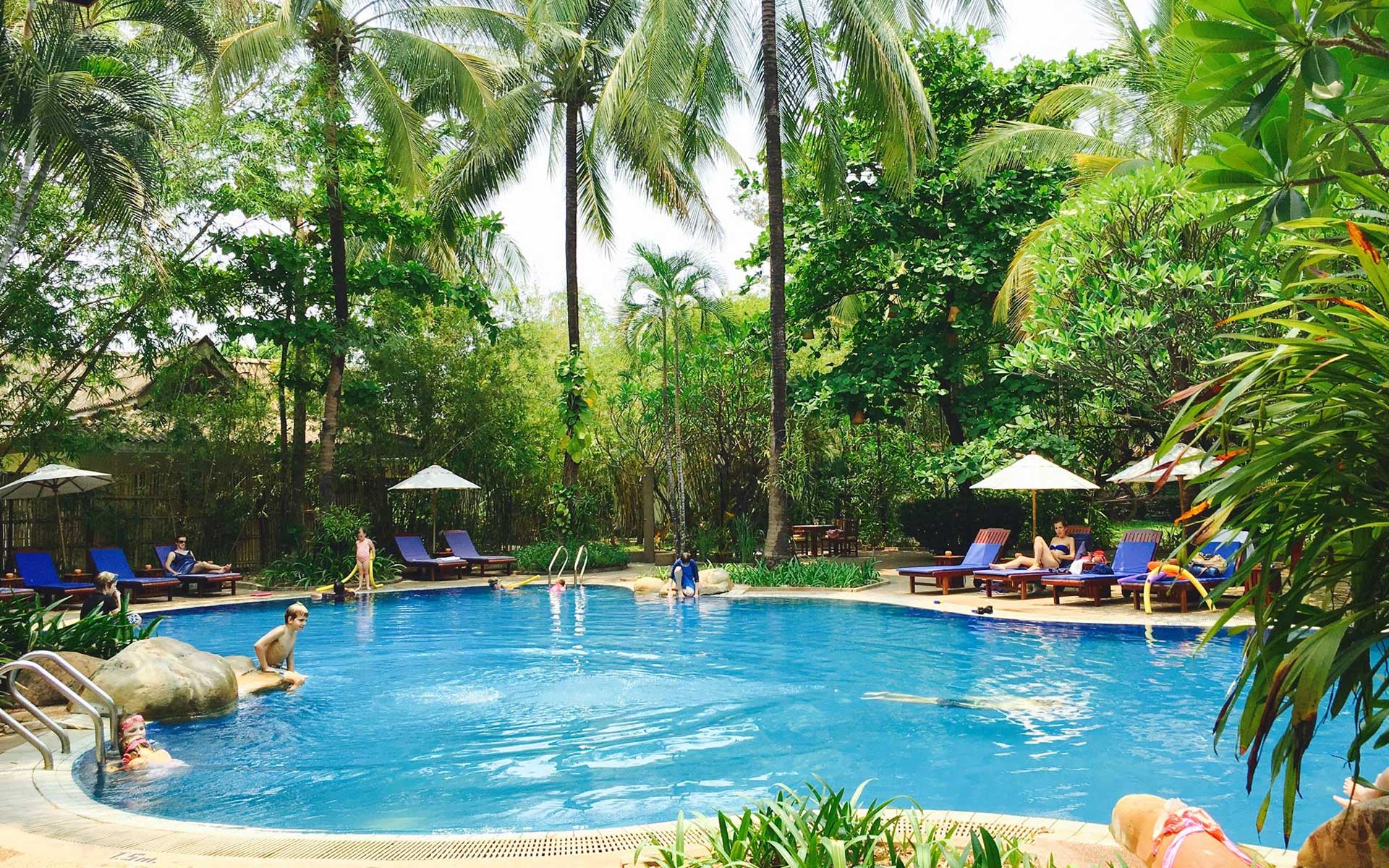
Swimming pool area at Settha Palace Hotel, a luxury boutique hotel with French colonial architecture in Vientiane.
Add: 6 Pangkham Street, Vientiane
Tel: +856 (21) 217 581
Crowne Plaza Vientiane
Add: 20 Samsenthai Road, Nongduang Nua Village, Sikhottabong District, Vientiane
Tel: +856 21 908 888
Travel Advisory.
– Ready for your Laos trip with all necessary documents before flying, including a good travel insurance, visa, valid passport, passport sized photos, permitted amount of money for import/export, cash for visa fee;
– Research information to understand Laos cultural norms and avoid the culture shock. Here are some important Dos and Don’ts that you should know before trip to Laos:
- Dress clean and neatly at any religious places;
- Ask permission when taking photos with the locals or step over someone in your path;
- Only use your feet to walk or play sports as feet is “low part” in Laos;
- Take off your shoes before entering any Laotian home;
- Don’t touch the monk, monk’s robe or someone’s head;
- Don’t raise your voice at the publicity;
- Don’t show public displays of affection or wear swimsuit/bikini to walk around as it is the impolite gestures to Laotian community
– Prepare suitable packing list according to your travel month. It normally includes summer gear with T-shirts, shorts, comfortable footwear and a couple of formal clothes for special place. A set of warm clothes should be packed if you travel in December and January, especially in Laos mountainous areas where the temperature can drop low. For wet season, a lightweight raincoat is a wise;
– Some other personal items need to be added with your travel, such as sunscreen, sunglass, hat, insect repellent, toiletries, little medical kit or your own medications, refillable water bottle, earplugs, a universal travel adaptor, unlocked mobile phone to use Lao sim card, a backpack for day trips;
– Take care of your personal things while in public and keep valuable things in safe place;
– Keep the copies of your personal documents while outside for safety;
– Make the earliest service reservations prior to the trip in peak season to avoid any fully-booked status or lower quality than you expect.
With the hope to deliver all best things to know before traveling to Vientiane, Laos Travel team wish that this travel guide of Vientiane is helpful for your knowledge. As you can see, this sleepy capital has more than enough to fill your schedule, albeit at a leisurely pace. Whenever you plan a trip to Laos, just contact us and our team will be more than happy to assist and bring you a memorable experience to Laos!

